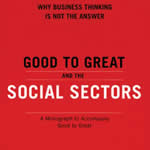A passionate essay in the UK Times rails against the emerging emphasis on access and public palatability among museums, claiming that it distracts and destroys the true purpose of the institutions. According to novelist/journalist James Delingpole, that true purpose is this: They exist today, just as they did 250 years ago, for the preservation, collection, […]
Measuring progress in ”smiles per hour”
Let’s assume you wanted to foster a sustainable and vibrant community over time, and you wanted to be publicly accountable to that goal along the way. What would you do? The city of Port Phillip, Victoria, Australia, came up with 13 indicators of what they believed to be a sustainable community, and then dared to […]
And you thought you had a youth marketing problem
A recent consumer product survey asked me what I thought of the product concept shown here, with the following marketing text: Natural spring water in the Aquapod bottle is the cool new kid on the block — Aquapod makes drinking water fun. Its unique bottle style is intriguing enough to get kids excited to drink […]
Feeling the squeeze
Grant Thornton just released its 12th annual ”Survey of U.S. Business Leaders,” which seeks to capture the tone and strategy of for-profit business decision-makers and their sense of the current business climate. A few of their major trend discoveries should sound strangely familiar to nonprofit cultural managers, and the corresponding strategies seem handy, as well […]
Economic impact: strike two
More trouble is bubbling for those who hope to make economic arguments for major public/private capital projects — for sports specifically, but also by proxy for the arts. This article in the Boston Globe suggests that the equation linking major facilities to major economic return is losing believers, if not losing steam: This new skepticism […]
What does a ”great organization” look like?
Jim Collins’ business best-seller, Good to Great, is an inspiring read for cultural managers. But even better is his specific monograph on the application of his thinking to the social sectors. It’s only 35 pages, but it contains volumes of insight and action steps.
The next generation
I’m off blogging in another part of the ether this week (although I will still be posting here, as well), with another iteration of the ”Hessenius Group,” a hosted conversation curated by arts policy wonk Barry Hessenius. This week, the topic is young professionals in nonprofit and public cultural institutions, and the questions in play […]
Knowing your audience, knowing your stuff
An interesting overview of Trader Joe’s in the New York Times (also summarized here) sheds some light on this quirky but successful grocery chain: There is nothing quite like the chain anywhere else on the American food landscape. ”Trader Joe’s is radically different in many ways from other food retailers,” said Stephen Dowdell, editor in […]
Do we ”age into” arts attendance?
In a comment to my post yesterday about demographic shifts in the labor market, a weblog reader asked the essential question: Won’t the aging Boomers come into the demographic that attends cultural events? Older, empty nesters with education and assets? Or are they too glued to their TV’s? It’s a common question and a core […]
Attracting the ‘young and the restless’
A December 2005 study from CEOs for Cities (available for download here, and discussed in the Washington Post) puts a finer point (or perhaps an exclamation point) on the ”Creative Class” hysteria of the past few years. Beyond the hazy competition among cities in luring creative workers, this study suggests the real competition should be […]


